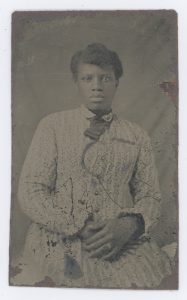The students of Curating Hidden Collections & the Black Archive worked tirelessly to uncover the provenance, date range, and techniques used to produce the photographs of the Baltimore Collection, as well as the identities of the sitters and photographers. We spent months examining and reexamining the individual photographs. We carefully described them to recover the lives that these objects documented. Despite our best efforts, however, the majority of the sitters in the Baltimore Collection remain unidentified.

“Portrait of an unidentified woman sitting,” (title devised by cataloger), The Baltimore Collection, accession number 2001.0017.0043, University of Delaware Library, Museum, and Press.
One these women fascinated me from the first time I saw the photograph above. She faces the camera directly, locking eyes through the photographic plane with her viewer. Her hair is carefully pinned back into three sections, the parts separating her locks captured clearly by the photographer. Her hands are crossed left-over-right on her lap, revealing that she is wearing a ring on her left ring finger. Her dress features a fitted bodice, perhaps pleated, that fastens up the torso with contrasting-colored buttons, light circles inscribed in alternating dark and light rings. The cloth is a simple star pattern, perhaps cotton. Color has been added to her cheeks, giving them a rosy hue and adding liveliness to her face. This was a technique common with tintypes such as hers, giving a date range between the 1850s and the early 1900s.
I have had difficulty identifying many details of the photograph. Her clothing does not reveal to me a potential date range. The design of her dress is simple, timeless. It lacks the identifying traits of high style dresses from the period, such as increasingly voluminous sleeves and skirts. The image does not have mount, hiding the name of the photographic studio, the photographer, and the city in which it was taken. The object lacks inscriptions that might point to the identity of the sitter or the previous owner or owners of the photograph. Time has made her anonymous to me and many others.
And yet, rather than merely accepting these silences, I turned to a tool that we discussed in class – imagination.
When the structure of the archive silences the voices it seeks to preserve, we can envision a new design through conversation, sharing, and building partnerships between institutions and the communities whose history they seek to understand.[1] I used this concept on a smaller scale to consider different questions about the life of this unidentified sitter, opening myself to the many possibilities about her life and considering what might have led her to this moment, capturing her imagine permanently in a tintype.
For whom did she have this photograph taken? A loved one? A partner? Herself? Was this the first time when she had her photograph taken? The last? The irreproducible nature of the tintype makes this photograph a once-in-a-lifetime moment.
Did she choose the light-colored cloth background for her photograph? Did she imagine how the light would reflect off the background and dance along her light-colored dress, highlighting the star pattern? Was this one of many options available at the studio or did she simply use the only option?
Did she make the dress herself, carefully sewing the ruffle along the cuff of her sleeves? Did she select the cotton cloth, insisting that it suited her and would set off the buttons? Did she choose to leave the dark contrasting ribbon around her collar untied with the two sides carefully overlapping one another? Or was the dress a costume owned by the photography studio, handpicked by the sitter and the female assistants often hired to help dress the sitters?
Was the ring on her finger indicative of marriage? Did she place her hands left over right to signal to the viewer her status as a married woman? Or perhaps her significant other had died and the act of holding her hands in this manner was a memorial?
I still have so many unanswered questions about the sitter. But by invoking imagination and envisioning the life that led her to have her photograph taken, I was able to breathe life into her image once again.
Allison Robinson
Winterthur Program in American Material Culture
Class of 2018
[1] Marisa Elena Duarte & Miranda Belarde-Lewis, “Imagining: Creating Spaces for Indigenous Ontologies,” Cataloging & Classification Quarterly, 53:5-6, 677-702, DOI: 10.1080/01639374.2015.1018396

